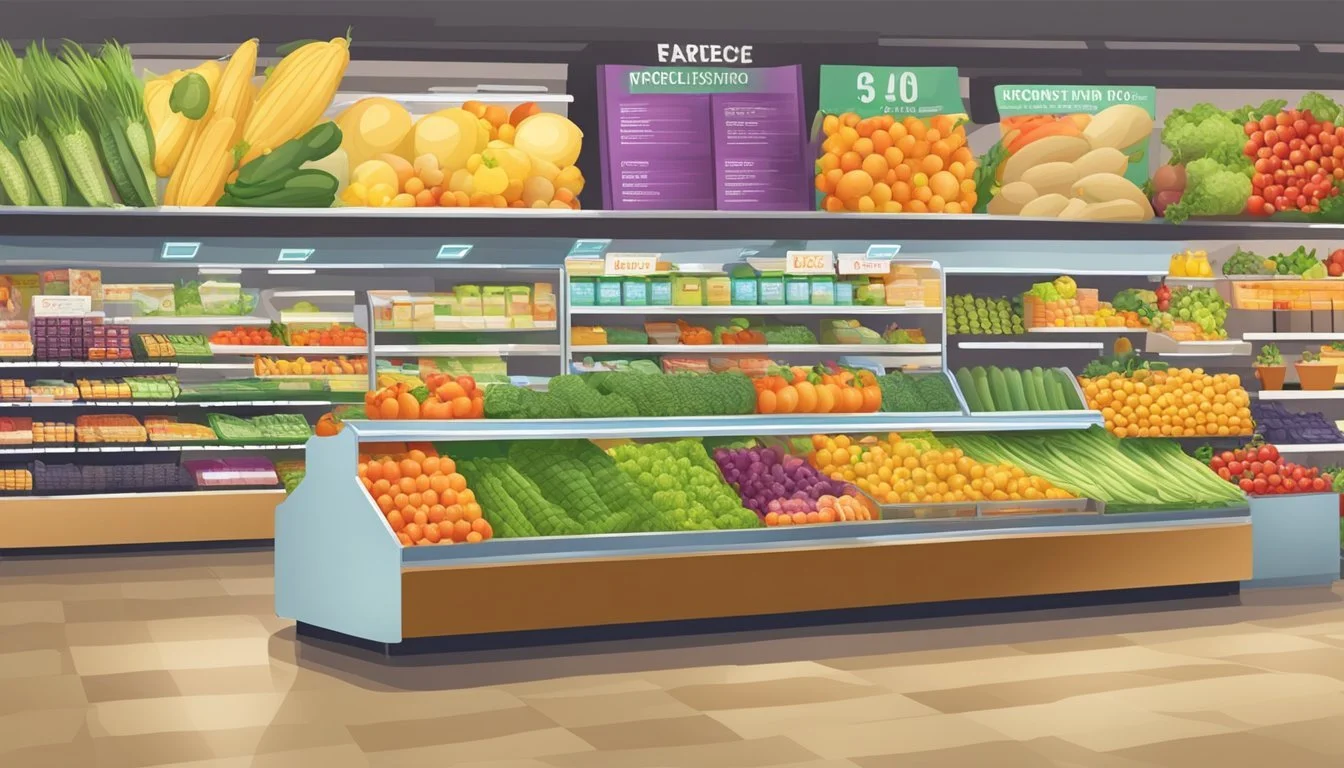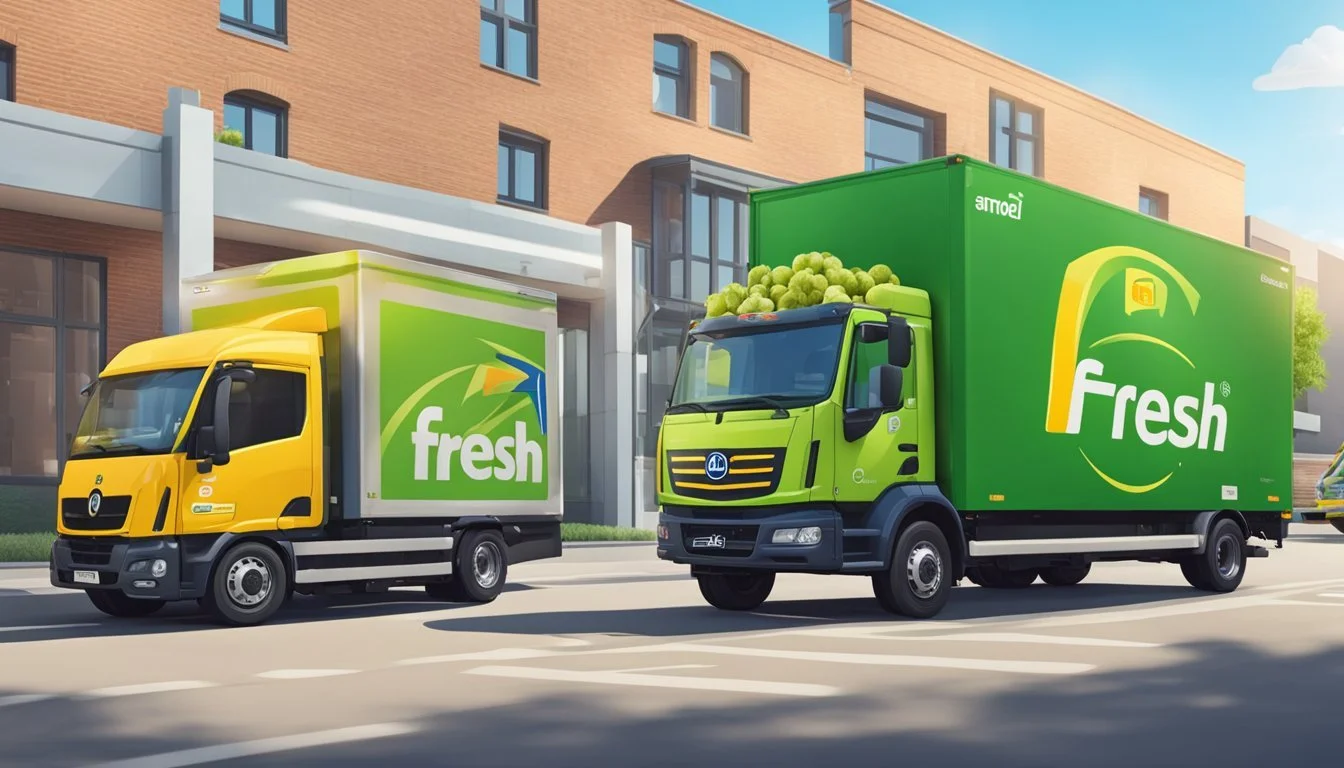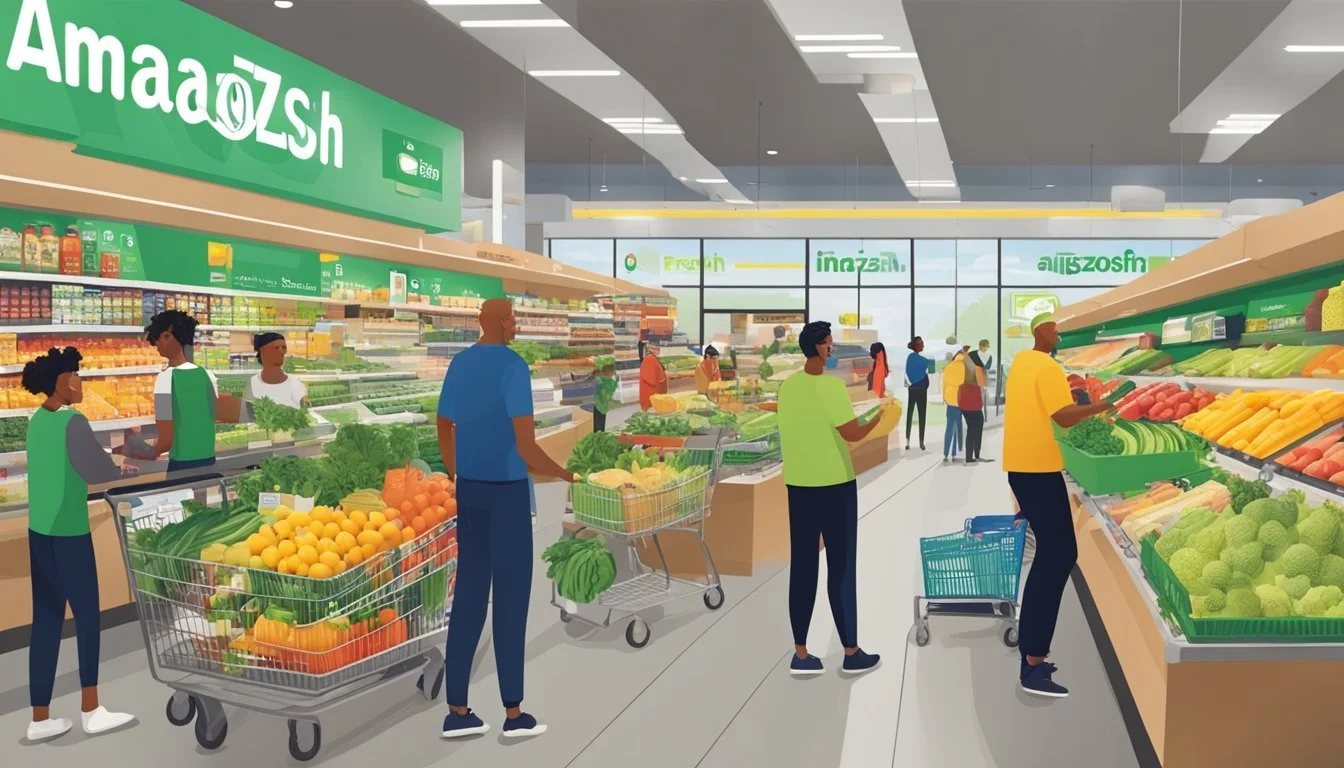Amazon Fresh vs Lidl
Comparing Prices, Quality, and Convenience
In the ever-evolving landscape of grocery shopping, consumers are constantly seeking the best value for their money. Amazon Fresh and Lidl represent two distinct approaches to meeting shoppers' needs. Amazon Fresh, an online grocery delivery service, offers convenience and a wide selection of products. Lidl, a German discount supermarket chain, focuses on providing low prices in physical store locations.
When comparing prices, Amazon Fresh tends to be competitive with traditional grocery stores, often offering lower prices on many items. However, Lidl's business model is specifically designed to provide deeply discounted prices on a curated selection of products. This difference in approach means that shoppers may find better deals at Lidl on certain items, while Amazon Fresh might offer more variety and the added convenience of home delivery.
The choice between Amazon Fresh and Lidl ultimately depends on individual priorities. Those who value convenience and a broad product range may prefer Amazon Fresh, while budget-conscious shoppers looking for in-store bargains might lean towards Lidl. Both options have their strengths, and savvy consumers may find benefits in utilizing both services to maximize savings and convenience.
Company Overviews
Amazon Fresh and Lidl represent two distinct approaches to grocery retail. Amazon Fresh leverages technology and Prime membership benefits, while Lidl focuses on efficient operations and low prices. Both aim to provide value to customers through different business models.
Amazon Fresh: Revolutionizing Grocery Delivery
Amazon Fresh is Amazon's grocery delivery and pickup service. Launched in 2007, it has expanded to major cities across the United States. Prime members can access Amazon Fresh for free with orders over a certain threshold.
The service offers a wide selection of fresh produce, meats, dairy, and pantry staples. Amazon Fresh also features Whole Foods Market products and Amazon-branded items.
Customers can shop online or via the Amazon app. Delivery options include attended delivery, doorstep delivery, and pickup at select locations.
Amazon Fresh integrates with Alexa for voice ordering and uses advanced logistics to ensure fresh, timely deliveries.
Lidl: A European Supermarket Giant
Lidl is a German-based discount supermarket chain founded in 1973. It expanded rapidly across Europe and entered the U.S. market in 2017.
The company operates over 11,000 stores in 32 countries. Lidl's business model focuses on efficiency and low prices.
Lidl stores are typically smaller than traditional supermarkets. They offer a curated selection of products, with about 90% being private-label brands.
The chain is known for its weekly specials on non-food items like clothing and household goods. Lidl emphasizes fresh produce, in-store bakeries, and sustainably sourced products.
Lidl's no-frills approach includes measures like customers bagging their own groceries and bringing their own bags.
Convenience and Shopping Experience
Amazon Fresh and Lidl offer distinct approaches to grocery shopping. Each retailer provides unique features that cater to different consumer preferences and lifestyles.
Navigating the Online Aisles
Amazon Fresh excels in the digital realm. Its user-friendly website and app allow customers to browse products, create shopping lists, and place orders with ease. The interface is intuitive, with clear categorization and search functionality. Shoppers can filter items by dietary requirements, price, or brand.
Lidl's online presence is more limited. While they offer an app for viewing weekly specials, their focus remains on in-store shopping. Some Lidl locations partner with third-party delivery services, but this varies by region.
Amazon Fresh's digital platform remembers past purchases, suggesting frequently bought items for quick reordering. This feature saves time for repeat customers.
Store Layout and In-Store Shopping
Lidl stores follow a consistent layout across locations. Their compact design allows for efficient shopping trips. Products are often displayed in their original shipping boxes, reducing overhead costs.
Amazon Fresh physical stores incorporate technology to enhance the shopping experience. Their "Just Walk Out" technology enables customers to skip the checkout line entirely. Shoppers scan a QR code upon entry, pick up their items, and exit without stopping to pay.
Lidl emphasizes a no-frills approach, with a rotating selection of limited-time specialty items. This creates a "treasure hunt" atmosphere, encouraging frequent visits.
Accessibility and Geographic Reach
Lidl boasts a wider physical presence, with thousands of stores across Europe and a growing number in the United States. Their focus on strategic locations makes them accessible to a broad customer base.
Amazon Fresh has fewer physical locations but compensates with extensive delivery coverage. In areas where Amazon Fresh delivers, customers can receive groceries at their doorstep within hours of ordering.
Zip code availability plays a crucial role in Amazon Fresh's service. Urban and suburban areas typically have better access to same-day or next-day delivery options.
Lidl's brick-and-mortar approach ensures consistent availability within their service areas. This model benefits customers who prefer immediate access to products and enjoy the tactile experience of in-person shopping.
Pricing and Membership
Amazon Fresh and Lidl offer distinct pricing models and membership structures. These differences impact overall costs and shopping experiences for customers.
Understanding the Cost Structure
Amazon Fresh prices are generally comparable to average grocery stores. Some items may be slightly cheaper, like eggs at $3.99 compared to $4.99 at other retailers. Prime members enjoy free delivery on orders over $35-$50, depending on location. Non-Prime customers pay delivery fees.
Lidl, a discount supermarket chain, focuses on everyday low prices. They offer a mix of private label and name-brand products. Lidl's streamlined operations and limited product selection help keep costs down. No membership is required to shop at Lidl stores.
Membership Benefits and Drawbacks
Amazon Prime membership, priced at $139 annually or $14.99 monthly, includes Amazon Fresh access. Benefits extend beyond grocery shopping, with free shipping on Amazon orders and streaming services. Prime members can earn 5% cashback using the Amazon Prime Rewards Visa Card.
Lidl doesn't have a membership program. This means no recurring fees, but also no exclusive discounts or perks. Shoppers can access Lidl's low prices without commitment. The lack of delivery options may be a drawback for some customers.
Product Selection and Availability
Amazon Fresh and Lidl differ significantly in their product offerings and availability. These differences impact the shopping experience and options available to customers.
Variety and Categories of Goods
Amazon Fresh boasts a wide selection of products across numerous categories. Customers can find everything from fresh produce to pantry staples, specialty foods, and household items. The online platform allows for a vast inventory, including many national brands.
Lidl focuses on a more curated selection. Their stores carry around 3,500 products, emphasizing private-label items. This approach allows Lidl to offer lower prices but may limit choices for brand-loyal shoppers.
Both retailers stock organic options, but Amazon Fresh typically provides a broader range.
Freshness and Quality of Produce
Lidl prides itself on fresh, high-quality produce. Their stores often feature a "Fresh 5" weekly deal on fruits and vegetables. The company sources produce locally when possible, which can enhance freshness.
Amazon Fresh faces challenges in produce quality due to delivery logistics. However, they offer a satisfaction guarantee on fresh items. Some customers report inconsistent produce quality from Amazon Fresh deliveries.
Both retailers strive to maintain strict quality control measures for their produce sections.
Product Stock and Out-of-Stock Issues
Lidl's physical stores allow customers to see product availability instantly. However, popular items may sell out quickly, especially during promotional periods. Restocking occurs regularly, but specific product availability can vary by location and day.
Amazon Fresh's digital platform provides real-time inventory updates. Out-of-stock items are clearly marked, and customers can often choose substitutions. However, last-minute changes to orders due to stock issues can be frustrating for some shoppers.
Amazon's larger warehouse system generally allows for better stock management compared to Lidl's more limited store inventory.
Delivery Services
Amazon Fresh and Lidl offer contrasting approaches to grocery delivery. Amazon Fresh provides a comprehensive online service, while Lidl focuses primarily on in-store shopping with limited delivery options.
Examining Delivery Options
Amazon Fresh delivers groceries directly to customers' homes. Prime members can access the service for an additional monthly fee. Orders over $35 qualify for free delivery in most areas.
Lidl's delivery service is less extensive. The company partners with Instacart in select locations to offer home delivery. Customers can order through the Instacart app or website.
Amazon Fresh allows users to schedule deliveries up to a week in advance. Lidl's Instacart partnership typically offers same-day delivery, but scheduling options may be more limited.
Speed of Delivery and Scheduling
Amazon Fresh provides 1-hour and 2-hour delivery windows in many areas. Customers can choose a convenient time slot when placing their order. This flexibility is particularly useful for those with busy schedules.
Lidl's Instacart delivery times vary based on shopper availability. Same-day delivery is often possible, but specific time slots may be limited. Delivery windows are typically longer than Amazon Fresh's, ranging from 2-4 hours.
Both services allow customers to track their orders in real-time. Amazon Fresh provides updates through the Amazon app, while Lidl orders can be tracked via Instacart.
Service Fees and Tipping
Amazon Fresh charges a service fee for deliveries under $50. Prime members receive free delivery on orders over $35 in most areas. Non-Prime members pay additional delivery fees.
Lidl's Instacart partnership involves separate fees:
Delivery fee (varies by order size and delivery time)
Service fee (percentage of order total)
Optional tip for the delivery person
Tipping is not required but encouraged for both services. Amazon Fresh allows customers to add a tip during checkout or after delivery. Instacart shoppers for Lidl deliveries can be tipped through the app.
Both services occasionally offer promotions or free trials to new customers. These deals can provide significant savings for first-time users.
Customer Experience
Amazon Fresh and Lidl offer distinct customer experiences, each with its own advantages and challenges. Their approaches to ordering, handling issues, and supporting customers differ significantly.
Ease of Ordering and Repeat Purchases
Amazon Fresh excels in convenience with its user-friendly online platform. Customers can easily filter products, create shopping lists, and set up repeat orders for frequently purchased items. The interface remembers past purchases, streamlining future shopping trips.
Lidl, as a traditional brick-and-mortar store, requires physical visits. However, many customers appreciate the ability to personally select their groceries. Lidl's stores are typically well-organized, making in-person shopping efficient.
Both retailers offer mobile apps. Amazon's app integrates seamlessly with Fresh ordering, while Lidl's app primarily focuses on digital coupons and weekly specials.
Handling Substitutions and Refunds
Amazon Fresh has a robust system for handling substitutions. If an item is unavailable, customers can choose to allow substitutions or not. When substitutions occur, Amazon often provides the replacement at no additional cost.
Refunds are processed quickly through Amazon's customer service channels. Their "Freshness Guarantee" ensures customers receive a refund if products don't meet quality standards.
Lidl handles substitutions and refunds in-store. Customers can easily exchange items or receive refunds with a receipt. Lidl's return policy is generally customer-friendly, allowing returns within a reasonable timeframe.
Customer Support and Problem Resolution
Amazon Fresh offers 24/7 customer support through various channels including phone, chat, and email. Issues are typically resolved quickly, with tracking information readily available for orders.
Customers can often solve problems independently using Amazon's extensive online help resources. The company's large-scale operations sometimes lead to standardized responses, which can be frustrating for complex issues.
Lidl provides in-store customer service during business hours. Staff members are usually available to assist with queries or problems. While this limits support to store hours, many customers appreciate face-to-face interactions for resolving issues.
Lidl's smaller scale often allows for more personalized problem resolution, though options may be more limited compared to Amazon's extensive resources.
Pros and Cons
Amazon Fresh and Lidl offer distinct advantages and drawbacks for grocery shoppers. Both provide unique value propositions that cater to different consumer needs and preferences.
Advantages of Amazon Fresh and Lidl
Amazon Fresh excels in convenience and selection. Prime members enjoy free delivery on orders over $35, saving time and effort. The service offers a wide range of products, including fresh produce, meats, and pantry staples. Customers can easily compare prices and find deals online.
Lidl shines in affordability and quality. The store offers competitive prices on groceries, often beating larger supermarkets. Lidl's private-label products provide excellent value without compromising on taste. The chain is known for its rotating selection of limited-time specialty items, adding variety to shopping trips.
Limitations and Considerations
Amazon Fresh requires a Prime membership, which may not be cost-effective for all shoppers. Delivery times can be limited in some areas, and customers can't personally select their produce. The service may not be available in all locations.
Lidl's in-store shopping experience means customers must travel and shop themselves. Store locations are limited compared to larger chains. The product selection can be smaller than traditional supermarkets, and some national brands may not be available. Lidl's cost-saving measures, like having customers bag their own groceries, may not appeal to all shoppers.
Strategic Partnerships and Market Position
Amazon Fresh and Lidl employ distinct strategies to strengthen their market positions and expand their reach. Both leverage partnerships and acquisitions to gain competitive advantages in the grocery industry.
Collaborations with Other Retailers
Amazon Fresh partners with various retailers to enhance its offerings. The company collaborates with Instacart for same-day delivery services, expanding its reach to customers who prefer quick grocery deliveries. Amazon also works with Target to sell its private-label products on the Target website, increasing brand exposure.
Lidl, on the other hand, focuses on strategic alliances with local suppliers. This approach allows the company to offer regionally-sourced products, appealing to customers who value local goods. Lidl's partnerships with smaller producers help it maintain competitive pricing while supporting local economies.
Amazon and Whole Foods: A Symbiotic Relationship
Amazon's acquisition of Whole Foods in 2017 significantly bolstered its position in the grocery market. This partnership allows Amazon Fresh to leverage Whole Foods' established brand and expertise in organic and natural foods.
Amazon Prime members enjoy exclusive discounts at Whole Foods stores, driving customer loyalty. The integration of Whole Foods products into Amazon Fresh's inventory expands the selection available to online shoppers.
This symbiosis enables Amazon to offer a wider range of high-quality products while utilizing Whole Foods' physical locations for order fulfillment and customer pick-up points.
Lidl's Expansion Strategies
Lidl focuses on aggressive expansion to strengthen its market position. The company rapidly opens new stores in strategic locations, often targeting areas underserved by other grocery chains.
Lidl's expansion strategy includes entering new markets through acquisitions of smaller regional chains. This approach allows Lidl to quickly establish a presence in unfamiliar territories while benefiting from existing customer bases.
The company also invests in e-commerce capabilities, partnering with delivery services to offer online shopping options. Lidl's expansion efforts aim to increase its market share and compete more effectively with established players like Walmart, Kroger, and Aldi.
Conclusion and Future Outlook
Amazon Fresh and Lidl continue to reshape the grocery landscape with their distinct approaches. Both retailers invest heavily in technology and efficiency to offer competitive pricing.
Amazon Fresh leverages its parent company's logistics network for speedy grocery delivery options. This gives them an edge in urban areas and among tech-savvy consumers.
Lidl focuses on a no-frills shopping experience with a curated selection of private-label products. Their expansion targets the East Coast, aiming to capture budget-conscious shoppers.
The future may see increased competition between these retailers and traditional supermarkets. Warehouse clubs could also face pressure as Amazon Fresh and Lidl refine their bulk-buying options.
Grocery delivery times are likely to improve as both companies optimize their operations. Amazon Fresh benefits from integration with Whole Foods Market, potentially expanding its organic offerings.
Consumer preferences will ultimately shape the success of these retailers. Factors like product quality, store atmosphere, and customer service will play crucial roles alongside pricing strategies.
As Amazon Fresh and Lidl continue to evolve, shoppers can expect innovative shopping experiences and competitive prices in select locations across the United States.









